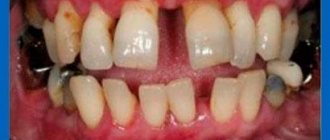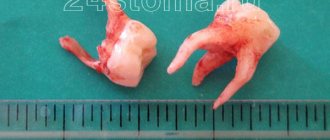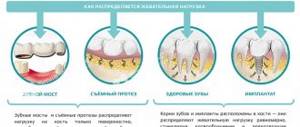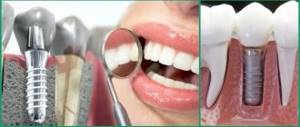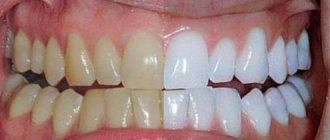Missing molars affects our health and appearance. It is not enough for the front teeth to be beautiful, straight, and white. The lateral areas of the dentition are no less important, even if they are not visible when we smile. Patients in dental clinics often do not attach much importance to the presence of molars and premolars, believing that the main thing is the frontal zone. But the lateral teeth are responsible for maintaining occlusal height. If they are lost, the front teeth move away from each other, unsightly gaps appear, the smile area loses its attractiveness, plus there is excess load and rapid wear of the remaining teeth.
Therefore, it is so important to restore teeth in the lateral and chewing zones, preferably immediately after extraction. What methods does modern dentistry offer for this? When restoring missing teeth, it is important to ensure the most physiological result possible. The choice of the appropriate method is based on the characteristics of the specific clinical picture.
Why is splinting of mobile teeth necessary?
With moderate and severe periodontitis, tooth mobility becomes one of the main symptoms of the disease. As a rule, tooth mobility begins when bone tissue atrophies more than 1/4 of the length of the tooth root. Those. There is a direct connection between the amount of bone atrophy and the degree of tooth mobility.
Exposure of the necks of the front teeth is one of the visual signs of bone tissue atrophy (Fig. 1). In this case, we can see bone loss on an x-ray. Normally, the bone tissue should reach almost to the neck of the tooth. Compare the radiograph (Fig. 2), where there is bone atrophy at 1/2 the length of the root, with the radiograph (Fig. 3), where atrophy is completely absent.
At the moment when tooth mobility occurs during periodontitis, the rate of destruction (atrophy) of bone tissue accelerates many times over. In turn, the destruction of bone tissue around the tooth leads to even greater tooth mobility. In fact (in the absence of treatment), the process becomes uncontrollable with constant progression of inflammatory symptoms, including tooth mobility.
Over time, under the influence of chewing load, the moving teeth begin to gradually change their position, tilt in different directions, and also fan out (Fig. 4-6). To prevent all this, teeth splinting is necessary.
Open bite
A type of disorder in which the teeth do not come together completely. If the degree is small, the deviation is not noticeable at first glance.
Open bite – the closure of the teeth is incomplete, the chewing process is impaired
What's the harm?
Violation of nasal breathing, especially during sleep, due to a constantly open mouth, leads to the development of chronic diseases of the respiratory system. Incomplete closure of teeth is the reason that it is difficult to fully chew food. In the future, this can provoke diseases of the gastrointestinal tract. Due to improper closure when chewing, the jaw joints also suffer.
All violations of the position of teeth negatively affect health and appearance, even if it is not noticeable at first glance. Straight teeth are not always the same as having a correct bite. Only an orthodontist can determine the disorder.
According to statistics, about 90% of people have bite problems. Even those violations that seem insignificant can lead to the destruction of enamel and, as a result, loss of teeth, as well as cause other problems: with breathing, jaw joints, posture and even stomach diseases.
Visit an orthodontist for a consultation if you have never been to this specialist before. If necessary, the doctor will recommend treatment and advise which system (braces or aligners) is better to choose.
Splinting mobile teeth with fiberglass –
Splinting of the lower anterior teeth - if the lower anterior teeth are splinted, then in this case, on the inner surface of, for example, the 4th, 5th or 6th lower anterior teeth, a horizontal groove is first made 1.5-2 mm high and 2 mm deep . Then a solid fiberglass tape is placed in this groove (Fig. 7). After which, the furrow (together with the fiberglass tape located in it) is filled with a light composite.
In Fig. 8-9 you can see what the inner surface of the lower teeth looks like “before and after” splinting.
The number of teeth that are taken into the splint will depend on the condition of the entire group of front teeth. In addition to the most mobile teeth, the splint must include fixed teeth (usually canines). This will relieve the movable cutters, because Thanks to the rigid splint, the fangs will take on most of the chewing pressure.
Splinting of the anterior upper teeth – splinting of the anterior upper teeth is used when teeth are mobile, when there is a threat, or when there is already a fan-shaped discrepancy of the teeth (Fig. 10). In this case, a groove 1.5-2 mm high and 2 mm deep is also drilled in the teeth. However, most often, a groove is drilled on the front surface of the upper teeth (Fig. 11), after which fiberglass tape is placed into it and covered with light-based filling material (Fig. 12-13).
Please note that with the help of filling material it is possible to eliminate wide interdental spaces (Fig. 13). The number of teeth that will be taken into the splint will depend on the clinical picture.
Splinting teeth: photo
Splinting of lateral teeth - if a lateral group of teeth is splinted, then a groove for the fiberglass tape is drilled not on the inner, but on the chewing surface of several teeth. Fiberglass tape is placed in the furrow in the same way and filled with a light composite.
As a result, the effect of splinting is achieved
When the fiberglass tape is illuminated, it turns into a very hard beam that is securely attached to the teeth. The teeth (with the help of such a beam) seem to be interlocked together and, as a rule, completely motionless.
A fiberglass beam on the teeth (splint) also allows you to redistribute the chewing load between the teeth (24stoma.ru). Even when biting on one tooth, the load will be evenly distributed over all teeth included in the splint. This is very important because... With periodontitis, the teeth are not only mobile, but also slightly divergent - they lose contact with each other.
The result of loss of contact between teeth is that each tooth bears the maximum load and is not able to distribute the load between adjacent teeth through such contacts. Under these conditions, bone tissue atrophies much faster. Splinting teeth in such conditions will significantly increase the service life of such teeth and stop (or slow down) bone atrophy.
Restoration of chewing teeth – end defect
In a situation where the location or number of teeth does not allow the use of bridges, the cheapest and simplest option is removable dentures. Such orthopedic structures rest on the gum or on the remaining teeth on one side. Reconstruction of the dentition with removable dentures restores chewing and speech activity, as well as the appearance of the patient’s face.
Removable dentures can be rigid or flexible. Representatives of each group have their own advantages and disadvantages. Thus, flexible prostheses are more comfortable, and patients adapt to them faster. However, they do not provide 100% correct transmission of the chewing load, and therefore atrophic processes in the bone are inevitable. Rigid dentures take time to get used to. During the adaptation period, rubbing of the mucous membrane and discomfort are possible. However, such structures are durable, repairable and more accurately transfer the load to the bone, slowing down its subsidence and atrophy.
Rigid prostheses are represented by the following types:
- Clasp – metal base, plastic crowns. The possibility of using a clasp denture is determined by the presence of at least six healthy teeth in a row.
- Lamellar – acrylic base, plastic crowns. Such dentures can be used both in the absence of molars and in completely edentulous patients.
Among flexible prostheses, silicone and nylon products are popular. They are extremely comfortable. The flexible part adjacent to the gum exactly imitates gum tissue. Fixation is carried out by suction; you can additionally use special adhesives.
An alternative to removable dentures is dental implantation. This is the most physiological way to restore teeth, providing a comfortable, aesthetic and durable result. Such restorations serve the patient for a lifetime, provided proper care and regular visits to the dentist.
Splinting of mobile teeth with crowns –
In this case, the teeth are first depulped (root canals are filled) and then ground down for crowns.
After that, crowns “soldered” to each other, for example made of metal ceramics, are put on them (Fig. 14). This splinting option has a significantly longer service life and reliability than fiberglass splinting. However, its cost is higher, and significantly. When splinting 6 front lower teeth with crowns, the cost of a structure of 6 units of metal-ceramics will be from 30 thousand rubles (not taking into account the cost of tooth removal). Splinting with all-ceramic crowns (Fig. 15) is another 2-2.5 times more expensive. However, when splinting distant chewing teeth, where aesthetics are not so important, it is possible to make crowns not from metal-ceramics, but from ordinary metal ones.
Distal bite
A bite in which the upper jaw is pushed forward relative to the lower jaw.
Distal bite – the lower row of teeth does not meet the upper one
What's the harm?
The chin looks sloping and underdeveloped. Because of this, already at a young age, sagging of the soft tissues in the lower part of the face occurs. The nose appears larger than it actually is, and the lower lip recedes. Sometimes nasal breathing is disrupted; during sleep, a person predominantly breathes through the mouth, which can cause diseases of the ENT organs.
Splinting teeth with clasp dentures –
If you look closely at Fig. 16-17, you will see that in the area of the inner surface of the lower teeth the prosthesis has an additional thin arch that tightly covers each tooth. This allows the teeth to stand firmly in place and transfer the chewing load from themselves to such a metal arch, without experiencing overload.
The big advantage of such dentures is that they allow you not only to splint mobile teeth, but also to simultaneously restore missing teeth. Read more about this type of prosthesis here .
Splinting teeth: price 2021
How much does teeth splinting cost? The price in Moscow for 2021 in economy class clinics will depend on the number of teeth splinted, as well as the technique...
- Fiberglass splinting of 6 front teeth (with the Ribbond system) - about 6,500 rubles.
- Splinting 3 teeth with fiberglass – from 3500 rubles.
- The cost of splinting teeth with crowns (without the cost of preparing teeth): → with metal ceramics - from 6,000 rubles for 1 crown, → with metal-free ceramics - from 19,000 rubles for 1 crown.
- The cost of a splinting clasp prosthesis is from 25,000 rubles.
Deep bite
One of the most common malocclusions. With it, the upper teeth completely overlap the lower ones.
Deep bite – the upper row of teeth completely covers the lower one
What's the harm?
Even if the front teeth are straight, the smile will be too “closed”; the lower third of the face will look disproportionately small. Due to improper closure, the enamel of the chewing teeth suffers.
